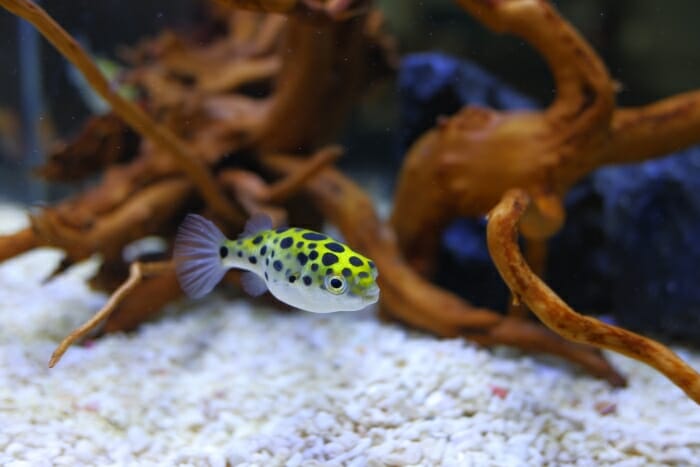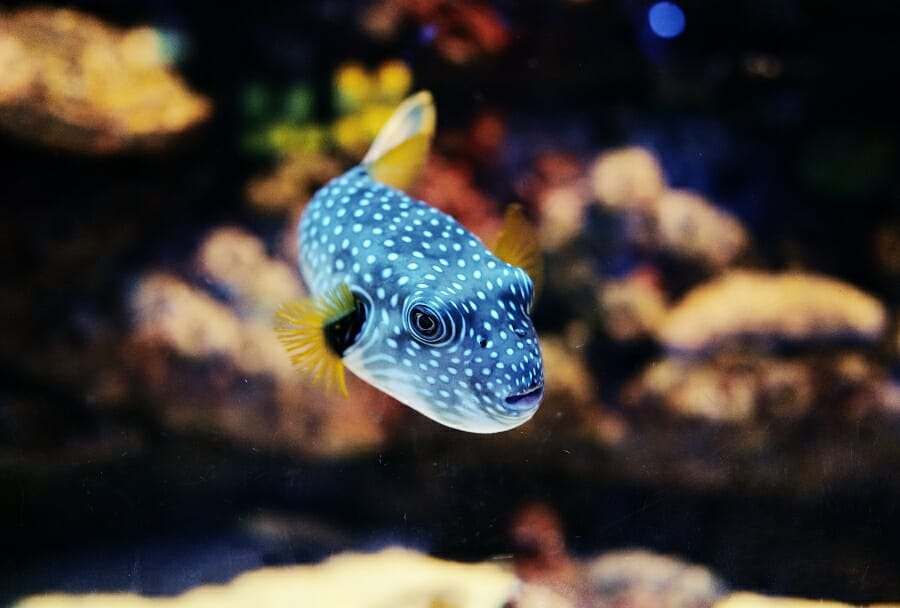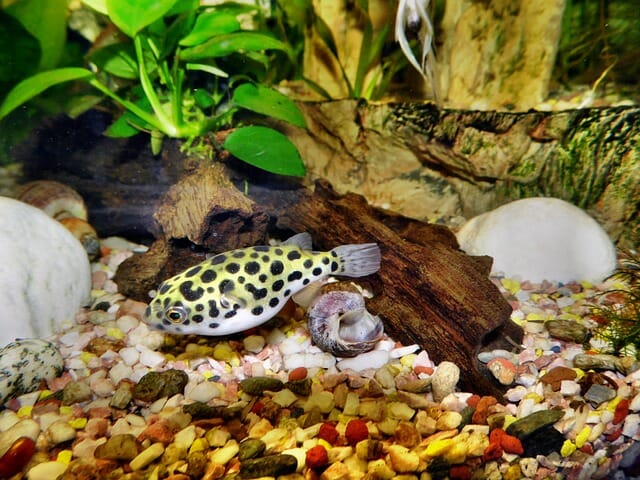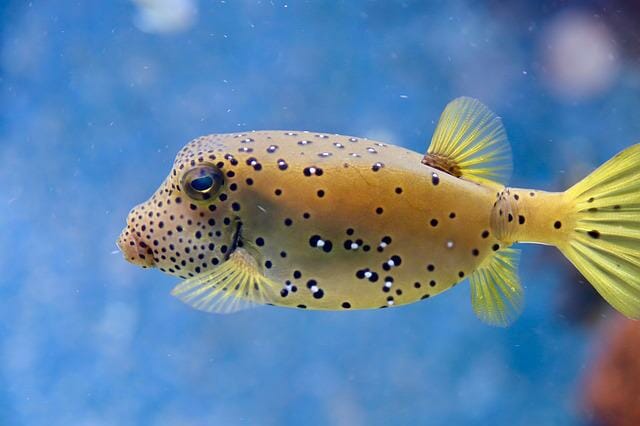Why Is My Puffer Fish Laying on the Bottom: Common Reasons and When to Worry

There could be several reasons your puffer fish is lying on the bottom, some easy to diagnose and others more complicated. The most common possibility is that your puffer fish may be sick or injured. If you notice any unusual behavior, such as lethargy or lack of appetite, take it to a vet for an examination. Injured puffer fish can often be rescued and will recover if given proper care.
Table of Contents
Is It Normal for Puffer Fish to Lay on the Bottom of the Tank?
There can be various reasons your puffer fish may lie on the bottom of its tank, but it is not necessarily indicative of any underlying health issues. Some common causes are territoriality or injury, which can often be detected and resolved without further intervention.
Notice that your fish has taken up residence on the bottom of the tank, and there seems to be no apparent reason for this behavior. So it might be best to bring your pet in for an examination by a veterinarian.
Another possibility is that your pufferfish might have taken up residence on the bottom in search of a safer place to stay. So, for example, if you’ve recently moved your fish or added new fish to the tank, it might be trying to find a territory.
Causes Why Puffer Fish Lay at the Bottom
Several reasons a puffer fish might lay on the bottom of its tank, including territoriality or injury. If you’re unsure what’s happening and your pet is displaying concerning behavior, it might be best to take it in for an examination by a veterinarian.
No Filtration
One potential cause of puffer fish laying on the bottom of its tank is inadequate filtration. If your aquarium lacks adequate mechanical or biological filtration, excess sediments and debris will build up over time. This can lead to stress in the fish, which may manifest in various ways.
Feeding Habits
One common cause of puffer fish laying on the bottom of its tank is improper feeding habits. If you’re not providing your pet with the proper diet, it may become stressed and seek refuge in a low-oxygen aquarium area.
This behavior can also be caused by overfeeding or using food that’s too rich in toxins. For example, a visit to a veterinarian will help determine if your pet is suffering from malnutrition or another illness, and appropriate care can be provided.
Unfavorable Habitat Features
Pufferfish are freshwater fish that thrive in a well-oxygenated environment. However, if your tank lacks adequate oxygen levels, your puffer fish may begin to exhibit symptoms such as reduced appetite, lethargy, and excessive laying on the bottom of its tank.

Aggressive Tankmates
One reason could be if it’s living in an environment with aggressive tankmates, such as other fish or coral. In this case, separating the pet from these aggressive individuals might help alleviate some stress and allow it to resume normal behavior.
Territoriality
If your fish is exhibiting signs of stress and anxiety, you may want to consider the possibility that it might be struggling with territoriality. Territoriality is a natural behavior exhibited by many animals as they strive to protect their space and resources. Laying on the bottom is one-way pufferfish communicate their status and territoriality in a community setting. If your puffer fish is lying down for whatever reason, give it some time and check back with us later to see if there’s anything more you can do to help its recovery.
If one area in an aquarium becomes overcrowded or stressed, fish will often retreat to lower levels to establish a sense of control.
Insufficient Space
Insufficient space can be one of the primary reasons a puffer fish will lay on the bottom. If your tank is too small, likely, there won’t be enough room for the fish to swim around and explore. This can lead to boredom and stress, which may cause them to seek refuge by lying on the bottom.
To prevent this issue, ensure you have a giant aquarium with plenty of open space for your pet pufferfish. Additionally, make sure to provide them with nutritious food and appropriate water conditions, so they don’t feel stressed or confined.
Unsuitable pH Levels
When a pufferfish transitions from its natural habitat to living in a human home aquarium with an artificially altered pH level, it may become stressed out and exhibit signs such as laying on the bottom or excessive hiding behavior. If your tank’s pH level is out of whack, it might be necessary to adjust it using premixed buffers or an essential water change.
Injury
If your puffer fish is lying on the bottom and appears in distress, it may have been injured. Signs of injury may include swollen or bleeding gills, difficulty breathing, and elimination changes such as having blood in the water.
If you notice any of these signs after your pufferfish has laid down on the bottom for a significant period, take them to a qualified veterinarian for further diagnosis and treatment.

Extremely High Temperature
When the water temperature rises too high, some puffer fish may lay at the bottom to escape the hot water. Laying on the bottom can increase your pet’s stress levels and cause them to die lethargically.
To prevent this issue, keep your aquariums within a comfortable range of 74-78 degrees Fahrenheit, and provide plenty of cool supplemental water during warm weather.
Extremely Low Temperature
When the temperature in your aquarium dips too low, some puffer fish may lay down to keep warm. Laying on the bottom can increase your pet’s stress levels and cause them to die lethargically.
To prevent this issue, make sure you provide enough room in your tank for them to swim around and avoid getting too close to the heater or cold water pipes. Additionally, add a layer of gravel or sand over part of their tank so they have something solid to rest their body.
Swim Bladder Disease
Pufferfish suffering from swim bladder disease may lie on the bottom of their tank and appear distressed. If you notice these signs, take your puffer fish to a veterinarian for further diagnosis and treatment.
Relaxation
If your pet is stressed, they may relax and lie on the bottom of their tank. This can signify that something is wrong with their environment or with them specifically. If you notice this behavior, take your puffer fish to a qualified veterinarian for further diagnosis and treatment.
When to Worry
If you have a puffer fish in your tank and it is displaying any of the following behaviors, it might be time to take it to see a vet:
- Lethargy or reduced appetite
- Poor energy levels
- Excessive laying on the bottom of the tank
Additionally, suppose your puffer fish is displaying any signs of illness, such as elevated water temperature levels or ammonia. In that case, these symptoms should not be ignored, and you should take your pet in for a check-up.
Help Your Puffer Fish Feel More Comfortable
Providing enough room in your aquarium for them to swim around and avoid getting too close to the heater or cold water pipes can help prevent your puffer fish from laying down on the bottom.
Adding a layer of gravel or sand over part of their tank, so they have something solid to rest their body can also help reduce stress levels. If you notice your pet exhibiting any signs of distress, take them to a qualified veterinarian for further diagnosis and treatment.
